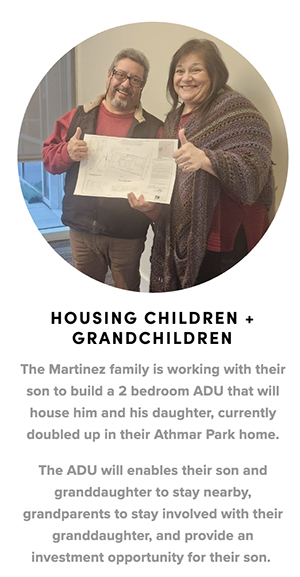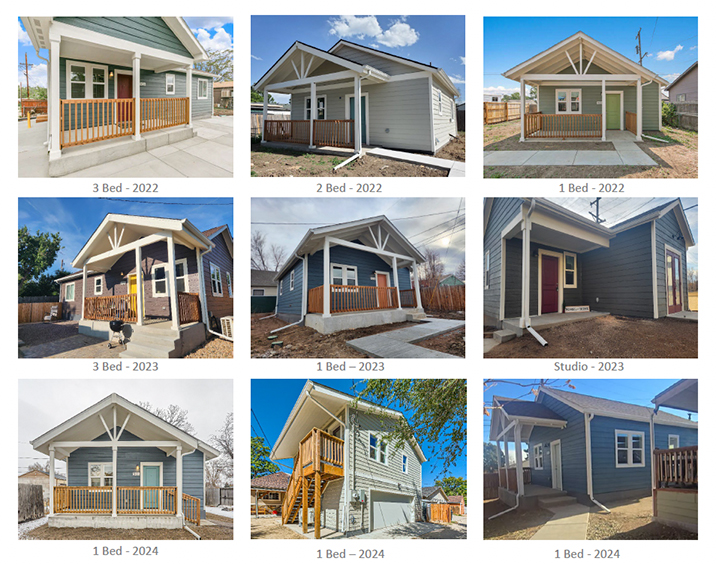West Denver Renaissance Collaborative
Background
 Denver is a rapidly growing urban center with a high demand for more affordable housing options near jobs and transit. As Colorado’s largest city, it has the biggest potential market for ADU development. Despite this opportunity, ADUs have not taken off there yet. The West Denver Renaissance Collaborative (WDRC) saw this as an opportunity to make ADUs more accessible and affordable, especially for low- and moderate-income homeowners in West Denver neighborhoods.
Denver is a rapidly growing urban center with a high demand for more affordable housing options near jobs and transit. As Colorado’s largest city, it has the biggest potential market for ADU development. Despite this opportunity, ADUs have not taken off there yet. The West Denver Renaissance Collaborative (WDRC) saw this as an opportunity to make ADUs more accessible and affordable, especially for low- and moderate-income homeowners in West Denver neighborhoods.
WDRC is a program of the Denver Housing Authority Planning & Data Department, working originally in nine neighborhoods in west Denver, now citywide to promote equity, leverage existing community assets, and plan for investments in the community and infrastructure.

Image source: West Denver Renaissance Collaborative
Program Design and Considerations
The West Denver Single Family Plus (WDSF+) ADU Pilot Program provides comprehensive support to help homeowners develop affordable ADUs. The program provides services and support through the entire process of ADU development, from predevelopment to construction. In exchange, participants must commit to renting the ADU long-term at lower-income rent rates.
In the mid 2010s, WDRC collected displacement data, using school district and voting records. They determined over 30,000 voter households had left the area in an eight year period, along with 8,400 school district families in a six year period. Supported by data showing rising rents and housing costs, along with a growing trend of developers purchasing foreclosed homes to resell at higher prices, WDRC recognized the need for a community-driven solution to help families stay in their homes. The community identified Accessory Dwelling Units (ADUs) as a promising approach—not only to increase housing supply but also to support wealth-building and stability. WDRC began designing the program and securing funding in 2018, launching in 2020.
WDRC provides a variety of support throughout the typical ADU process:
- Homeowner Technical Assistance: Before design even begins, homeowners receive a variety of resources including technical support with feasibility studies, surveys, site planning assessment, housing counseling, utility upgrade assessments, cost projections, referrals to lenders, and more.
- Providing Pre-Approved Plans: Homeowners can select from seven pre-approved detached ADU designs offered by the program, ranging from studios to three-bedroom units. Each design is energy-efficient to help lower utility costs and includes engineering and modeling services to fit the unique characteristics of each property.
- Partnering with Lenders to Provide Loans and Financing Opportunities: WDRC has worked with lending partners including First Bank, Huntington Bank, and UMB Bank to develop competitive, ADU-specific funding products that take into consideration the future value of the built ADU and future rental income, among other details, to help make projects more feasible. The WDRC team strongly feels that development of these lending products is key to building the market for ADUs, particularly in making them more affordable.
- Streamlining Permitting and Review: WDRC offers direct support with permitting, a process that becomes even more streamlined when homeowners use the pre-approved ADU designs and partner with Habitat for Humanity as the builder (see below). Additionally, WDRC has collaborated closely with the City and County of Denver and other public agencies to address offsite infrastructure improvements, which can be a significant financial barrier—especially in neighborhoods that have historically lacked the same level of investment in infrastructure like sidewalks and utilities as wealthier areas. (WDRC staff specifically pointed out that this disparity can make ADUs less expensive to build in more affluent neighborhoods.)
- Construction support: Homeowners earning below 120% AMI and using one of the pre-approved designs, can use Habitat for Humanity, a key program partner, as their builder. This partnership offers an average of 10% construction savings over other builders.
- Supporting Homeowners to Become Landlords: Homeowners also receive property management training to ensure long-term success in managing their ADU rental. Program participants are required to provide yearly proof of insurance and reports on how the ADU is being used, including a copy of the lease.
Incentivizing Accessible ADUs
Six of the pre-approved ADU plans are designed to meet ANSI Type B Adaptable Design Standards, allowing for seamless adaptation to fully accessible homes as needed. Key design standards include:
- Hallways and doorways wide enough for wheelchairs and walkers
- Six single-story units that minimize the need for stairs
- Blocking in walls for grab-bar installation
- Parallel approach to sinks for ease of use by wheelchair users
- Low-threshold step-in shower for independent bathing
 Incentivizing Affordable ADU Rentals
Incentivizing Affordable ADU Rentals
ADUs developed through the program are subject to a 25-year affordability covenant. Either the homeowner or the tenant must initially qualify at or below 80% AMI, and short-term rentals (less than 30 days) are not allowed. The ADU can house qualifying family members or be rented on a long-term lease. Participants are required to maintain insurance, provide annual reports on how the unit is being used, and submit lease documents to WDRC.
Sharing ADU Case Studies
WDRC provides short, inspirational stories from their program participants on their website, including how the ADU is used and the positive impact the project has had on their lives.
Takeaways
Partnerships were key to the WDSF+ ADU Pilot Program’s success. From the outset, WDRC collaborated with mission-aligned funders and lenders—such as Denver’s Department of Housing Stability (HOST), the Spark Initiative, Fannie Mae, and local banks like First Bank, Huntington, and UMB Bank—to secure financing options. They also partnered with the City’s infrastructure team to tackle key technical components, including right-of-way improvements, surveys, soil analysis, water, utilities, and other associated costs. Financing and technical assistance have been critical in helping homeowners overcome early barriers and navigate the ADU development process. The WDRC is now exploring local production of prefab ADUs as a way to further reduce costs for program participants and scale the production of ADUs.
The WDSF+ ADU Pilot Program highlights the value of pairing affordability incentives with comprehensive homeowner support. WDRC stressed the need to lower costs, provide hands-on assistance, and tailor programs to reflect local market realities—particularly in areas where ADU development is still gaining traction. Their design and development support bridges typical upfront predevelopment costs, allowing homeowners to move forward with their ADU project for just a $1,500 program deposit—instead of paying $20,000–$40,000 out of pocket. These costs are repaid at the start of construction once the homeowner’s project funding is secured.

The program provided technical assistance to 120 households in 2023-24. WDRC reports that since the first program-issued permit in 2021, they’ve been responsible for 11% of ADUs built in Denver (and 30% of ADUs in District 3), all of which are affordably restricted. Over half of their ADUs built, or in-progress, are 2 or 3 bedroom units. Of the first 26 households to participate, 77% were BIPOC families and 54% were female-headed households, with a median income of 74% AMI.
Resource Links
- WDRC WDSF+ ADU Pilot Program Webpage including the design catalog, program FAQs, and ADU Stories
- Habitat for Humanity of Metro Denver WDSF+ ADU Pilot Program Webpage
- Article: Can Accessory Dwelling Units Help Keep Families and Communities Intact? by Collective Colorado
Accessory Dwelling Unit (ADU) Toolkit
We're Here to Help!
Do you have questions about the new laws and impacts to your jurisdiction? Check out our FAQ page, visit our main State Land Use and Housing Legislation page to learn about all the laws, or get one-on-one support below: